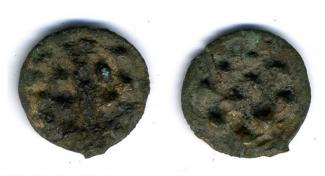Cast bronze coin of the Durotriges
Late pre-Roman Iron Age, early 1st century AD
Found at Hengistbury Head, Christchurch, Dorset
The two most powerful late Iron Age kingdoms, the Catuvellauni and Trinovantes to the north of the Thames and the Atrebates/Regni to the south, were surrounded by a broad arc of so-called peripheral tribes. These were tribes who were either prevented from direct interaction with Roman Gaul by their marginal position or who deliberately retained an anti-Roman stance throughout the last century of their independence. One of these tribes, the Durotriges, occupied the area of present day Dorset and Somerset. This coin is one of twenty-one coins found at the great late Iron Age trading centre at Hengistbury Head and donated to the museum in 1922. The coins bear a simple pattern of dots on each side and thus represent the ultimate debasement of the stater of Philip II of Macedon that had provided the inspiration for the first Celtic coins more than three centuries earlier.



